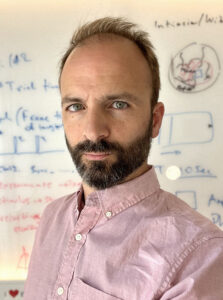Froudarakis Emmanuel
October 20, 2025 2025-11-03 8:58Froudarakis Emmanuel

Froudarakis Emmanuel
Assistant Professor of Physiology - Neurophysiology
Medical School, University of Crete, P.C. 70013 Heraklion, Crete
Emmanouil Froudarakis obtained his B.Sc. Degree in Biology at the National & Kapodistrian University of Athens. He continued his studies in Neuroscience in Utrecht University in the Netherlands and Baylor college of Medicine in Houston, USA where he got his Ph.D. in 2015 studying the neural representations of natural image statistics. He did his post-doctoral studies and worked as an Instructor of Neuroscience at Baylor College of Medicine. From 2019 he is a group leader at IMBB-FORTH and his lab investigates how cortical circuits across different brain areas interact to form representations that can guide behavior. In 2022 E. Froudarakis was elected Assistant Professor of Physiology-Neurophysiology at the Medical School, University of Crete. In 2022, he was awarded a Starting Grant from the European Research Council (ERC) to study the neural mechanisms for object recognition. He is currently a FENS-KAVLI Scholar.
2015 – 2017: Post-doc in Neuroscience
BAYLOR COLLEGE OF MEDICINE Houston TX, USA
2009 – 2015: Ph.D. in Neuroscience
BAYLOR COLLEGE OF MEDICINE Houston TX, USA
2001 – 2005: B.Sc. in Biology
NATIONAL & KAPODISTRIAN UNIVERSITY OF ATHENS Athens, Greece
Our lab investigates how cortical circuits interact to form transformation-invariant object representations that can guide behavior. Natural environment contains large number of objects with overlapping sensory input, and our brain is capable of using information from different sensory modalities to extract their identities with ease. Yet, despite extensive research in the last few decades, we are still far from having a complete understanding of how the brain creates untangled object representations. If we understood how cortex achieves this extraordinary ability at the algorithmic level, this would represent a significant advance in our understanding of brain computation in general. To address this question, we combine advanced imaging techniques for recording neural activity with high-throughput behavioral training and computational modeling to understand the algorithm used by the mouse visual cortex to extract relevant features from complex environments and guide natural behaviors.
Google Scholar: https://scholar.google.com/citations?user=peGMCr8AAAAJ&hl
Member of Federation of European Neuroscience Societies
Member of Hellenic Society for Neuroscience
Member of International Brain Research Organization



